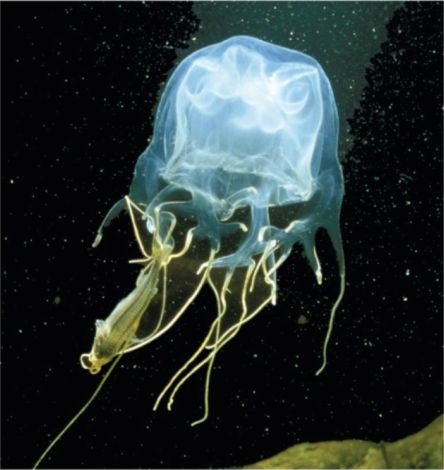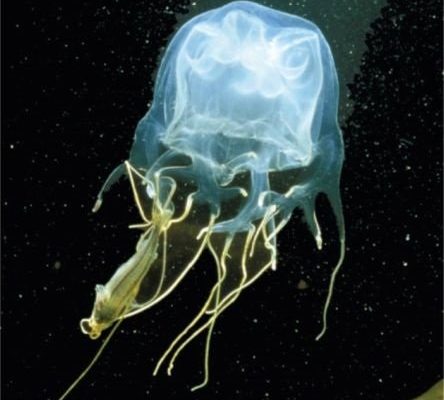
Imagine you’re at the beach, and suddenly a mysterious, umbrella-shaped creature floats by, trailing long, slender tentacles. This is the box jellyfish, known for its beauty and its sting. Today, let’s dive into the world of the box jellyfish and explore what it eats and how it finds its meals. It’s a journey through the underwater world that reveals some incredible facts.
What Exactly Is a Box Jellyfish?
The box jellyfish, scientifically known as *Chironex fleckeri*, is one of the most intriguing and, frankly, dangerous creatures in the ocean. With its cube-shaped bell and long tentacles, it can appear both enchanting and alarming. Found mainly in the warm coastal waters of the Pacific and Indian Oceans, these jellyfish thrive in shallow waters, especially around mangroves and estuaries.
Unlike their more common jellyfish cousins, box jellyfish are known for their highly developed sensory organs. They possess clusters of complex eyes that help them navigate through their watery environment. You might be wondering how something so ethereal can also be so predatory. That’s where their diet comes into play.
The Diet of Box Jellyfish
So, what do box jellyfish eat? Their diet primarily consists of small fish, plankton, and tiny invertebrates. Think of them as the ocean’s version of a slow-moving vacuum cleaner, sucking up whatever comes their way. When hunting, they extend their tentacles to capture unsuspecting prey. The process is pretty fascinating.
The tentacles are lined with specialized cells called nematocysts, which contain tiny harpoons loaded with venom. When prey contacts these tentacles, the nematocysts fire, delivering a potent sting that immobilizes the victim. This allows the box jellyfish to feast on its catch without much effort. Here’s a quick look at their favorite foods:
- Small fish
- Plankton
- Larval crustaceans
While they might not have the most sophisticated dining habits, box jellyfish are efficient hunters.
How Box Jellyfish Catch Their Prey
You might be thinking, “That sounds easy, but how do they do it?” The technique they use for capturing food is pretty clever. When a box jellyfish spots potential prey, it drifts closer and extends its tentacles.
The tentacles not only help with catching prey, but they also play a significant role in sensing the environment. The jellyfish can detect vibrations and movements in the water, allowing it to pinpoint the location of a meal. Once close enough, the tentacles reach out, and *bam*—the hunt is on!
It’s important to note that the box jellyfish’s hunting strategy is passive. This means they rely more on their environment and natural currents to bring food to them, rather than actively swimming around searching for meals. Imagine having a buffet coming to you instead of going out to find one.
Feeding Mechanism: The Role of Tentacles
Let’s get into the nitty-gritty of how the box jellyfish feeds. After capturing its prey with its tentacles, the jellyfish uses a unique feeding structure called the manubrium. This is a sort of tube-like extension that hangs down from the center of its bell.
Here’s how it works: once the prey is immobilized, the box jellyfish pulls it toward the manubrium using its tentacles. The creature then starts digesting its meal almost immediately. Instead of chewing, the jellyfish releases digestive enzymes that break down the food before absorbing the nutrients. It’s like having a takeout meal—no cooking involved!
While they don’t have a traditional stomach, the jellyfish’s simple body plan allows it to absorb nutrients efficiently. You might find it interesting that they can eat food that’s even larger than their own bell—a remarkable feat in the animal kingdom.
How Often Do Box Jellyfish Eat?
You could be asking yourself, “So, how often do they eat?” Unlike many animals that follow a strict feeding schedule, box jellyfish have a more laissez-faire approach to mealtime. Their feeding frequency can depend on several factors, such as the availability of food and environmental conditions.
In general, box jellyfish feed whenever they come across a meal, which can range from several times a day to just a few times a week. This flexible feeding pattern helps them survive in environments where food sources fluctuate. If you think about it, it’s like trying to grab lunch during a busy workday—you take it when you can!
The Impact of Diet on Box Jellyfish Populations
The diet of box jellyfish doesn’t just affect their individual health; it also plays a role in the ecosystem. As predators, they help maintain the balance in their marine environment. By controlling the populations of small fish and plankton, box jellyfish contribute to the overall health of the ocean.
However, changes in the ocean’s environment can impact their food sources. For instance, overfishing and pollution can reduce the availability of prey. As a result, box jellyfish populations could either decline or increase rapidly, leading to potential ecological consequences.
You might see this reflected in the rising number of jellyfish blooms, often triggered by changes in ocean conditions, which can disrupt local fishing industries and tourism. It’s a delicate balance that shows just how interconnected our world’s ecosystems really are.
Conservation and Box Jellyfish
While they may seem like simple creatures, box jellyfish play a critical role in their ecosystems. As such, understanding their diet and feeding habits also ties into conservation efforts. Protecting their natural habitats ensures that these jellyfish have access to the food they need.
To help protect box jellyfish and their environment, it’s essential to consider the broader impact of human activities. Efforts to reduce plastic pollution, manage fishing sustainably, and protect coastal ecosystems can all positively influence box jellyfish populations.
Here’s the thing: even though these creatures might sting, they’re an important part of ocean life. By raising awareness about their role in the ecosystem, we can contribute to their conservation and the health of our oceans.
The diet and feeding habits of the box jellyfish are as fascinating as the creatures themselves. From their unique hunting techniques to their impact on the marine ecosystem, there’s so much to learn about these mesmerizing organisms.
Next time you see a box jellyfish floating in the water, remember that it’s not just a pretty sight; it’s a clever predator, playing a crucial role in the balance of ocean life. Whether you appreciate them for their beauty or respect them for their potential danger, there’s no denying that these jellyfish are remarkable in their own right. Understanding their diet can help us appreciate the delicate balance we must maintain in our oceans, making sure they continue to thrive for generations to come.

